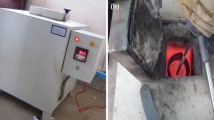Abstract
The tribological properties such as wear rate, hardness of the aluminum-fly ash composite synthesized by stir casting were investigated by varying the weight % of fly ash from 5 to 20 with constant weight % of zinc and magnesium metal powder. A mathematical model was developed to predict the wear rate of aluminum metal matrix composites and the adequacy of the model was verified using analysis of variance. Scanning electron microscopy was used for the microstructure analysis which showed a uniform distribution of fly ash in the metal matrix. Energy — dispersive X-ray spectroscopy was used for the elemental analysis or chemical characterization of a sample. The results showed that addition of fly ash to aluminum based metal matrix improved both the mechanical and tribological properties of the composites. The fly ash particles improved the wear resistance of the metal matrix composites because the hardness of the samples taken increased as the fly ash content was increased.
Similar content being viewed by others
References
I. Dinaharan, N. Murugan and S. Parameshwaran, Influence of in-situ formed ZrB2 particles on microstructure and mechanical properties of AA6061 metal matrix composite, Material Science and Engineering A, 528 (2011) 5733.
J. B. Fogagnolo, M. H. Robert, E. M. R. Navas and J. M. Torralba, 6061 Al reinforced with zirconium diboride particles processed by conventional powder metallurgy and mechanical alloying, Materials Science, 39 (2004) 127.
T. P. D. Rajan, R. M. Pillai, B. C. Pai, K. G. Sathyanarayana and P. K. Rohatgi, Fabrication and characterization of Al-7Si-0.35Mg/fly ash metal matrix composites processed by different stir casting route, Composites Science and Technology, 67 (2007) 3369.
J. Babu Rao, D. Venkat Rao and R. Bhargava, Development of light weight ALFA composites, Engineering, Science and Technology, 2 (11) (2010) 50.
M. Ramachandra and K. Radhakrishna, Effect of reinforcement of fly ash on sliding wear, slurry erosive wear and corrosive behavior of aluminum matrix composite, Wear, 262 (2007) 1450.
M. Ramachandra and K. Radhakrishna, Synthesis-microstructure-mechanical properties -wear and corrosion behavior of Al-Si (12%) — Fly ash metal matrix composite, Material Science, 40 (2005) 5989.
R. L. Deuis, C. Subramanian and J. M. Yellup, Abrasive wear of aluminum composites — a review, Wear, 201 (1996) 132.
A. P. Sannino and H. J. Rack, Dry sliding wear of discontinuously reinforced aluminum composites: review & discussion, Wear, 245 (2000) 22.
S. Mohanty and Y. P. Chugh, Development of fly ash-based automotive brake lining, Tribology International, 40 (2007) 1217.
J. B. D. De Mello, Three-body abrasion of Al-Si composites, Wear, 225 (1999) 163.
S. C. Tjong and Z. Y. Ma, Microstructural and mechanical characteristics of in- situ metal matrix composites, Materials Science and Engineering, 67 (2000) 3369.
D. Tabor, The hardness of metals glasgow: Oxford University Press, UK (1951).
G. Withers, Dispersing fly ash particles in an aluminum matrix, Advanced Materials and Processes (2006) 39.
W. G. Cochran and G. M. Cox, Experimental design, Asia Publishing House, India (1963).
D. G. Montgomery, Design and analysis of experiments, John Wiley and Sons, NY (2009).
P. S. Sivasakthivel, V. Vel Murugan and R. Sudhakaran, Prediction of tool wear from machining parameters by response surface methodology in end milling, Engineering Science and Technology, 2 (6) (2010) 1780.
H. Oktem, T. Erzurumlu and H. Huurtaran, Application of response surface methodology in the optimization of cutting conditions for surface roughness, Materials Processing and Technology (2005) 170.
I. Dinaharan and N. Murugan, Dry sliding wear behavior of AA 6061 / ZrB2 in- situ composite, Transactions of Nonferrous Metals Society of China, Elsevier, 22 (2012) 810.
T. J. A. Doel, M. H. Loretto and P. Bowen, Mechanical properties of aluminum based particulate metal matrix composites, Composites, 24 (1993) 270.
A. P. Sannino and H. J. Rack, Tribological investigation of Al-20 volume % SiCp/17-4 pH, Part 1 Composite Performance, Wear, 196 (1996) 202.
H. Gletier, Nanostructured materials; Basic concept and microstructure, Acta Materialia, 48 (1) (2000).
T. Rajmohan, K. Palaanikumar and S. Ranganathan, Evaluation of mechanical and wear properties of hybrid aluminium matrix composites, Trans. Nonferrous Met. Soc. China, 23 (2013) 2509.
J. Zhang and A. T. Alpas, Delamination wear in ductile materials containing second phase particles, Mater. Sci. Eng. A, 160 (1993) 25.
B. D. Cullity and S. R. Stock, Elements of X-ray diffraction, Upper Saddle River. NJ: Prentice Hall (2000).
Author information
Authors and Affiliations
Corresponding author
Additional information
Recommended by Associate Editor In-Ha Sung
S. Selvi graduated in 1992 with a degree in M.E. degree (with Distinction) from Anna University, Chennai. She obtained her Ph.D. in Mechanical Engineering in 2010 from Bharathiar University, Coimbatore. She has received the best paper award from Indian Institute of Welding (IIW) in 2008 and second best paper award from BHEL, WRI, Trichy in 2009. Currently she is an Associate Professor in Mechanical Engineering, IRTT, Erode. Her main research activities focus on metal matrix composites, welding and hardfacing.
E. Rajasekar completed his M.E. degree (with Distinction) in Automobile Engineering discipline in 1992 from Anna University, Chennai and Ph.D. in Mechanical Engineering in 2011 from Anna University, Chennai. He is an Associate Professor in Automobile Engineering, IRTT, Erode. He is an active member in the SAE India, Combustion Institute, Institution of Engineers (India) and ISTE. His research interest is mainly on automotive materials, alternative fuels for IC Engines and renewable energy.
Rights and permissions
About this article
Cite this article
Selvi, S., Rajasekar, E. Theoretical and experimental investigation of wear characteristics of aluminum based metal matrix composites using RSM. J Mech Sci Technol 29, 785–792 (2015). https://doi.org/10.1007/s12206-015-0140-z
Received:
Revised:
Accepted:
Published:
Issue Date:
DOI: https://doi.org/10.1007/s12206-015-0140-z




